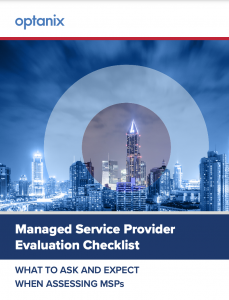
Managed IT Service Provider Pricing: What Should You Expect?
Managed service provider pricing is typically very straightforward. The pricing models are usually subscription-based. Additionally, most managed service providers maintain price lists that list their rates for managing various applications and device types.
Many managed service providers also offer pricing calculators to help potential customers determine the cost of leveraging their services. However, there are certain considerations you should make on your own before deciding to outsource your IT operations (after all, such calculators are designed to paint the managed service providers offering them in a positive light).
For instance, you will want to determine what it would cost you to take a DIY approach to IT operations instead of outsourcing. And if you do decide to outsource, among other things, you will want to determine which deployment model best suits your business and the amount of professional services you will require. You will also want to be cognizant of the fact that the cost of your managed service could change as the size and composition of your managed environment changes.
 Need insight on evaluating a managed service provider for your organization? Download this MSP Evaluation Checklist to ensure you select the best partner.
Need insight on evaluating a managed service provider for your organization? Download this MSP Evaluation Checklist to ensure you select the best partner.
DIY Costs vs. Managed Service Provider Costs
The benefits of leveraging a managed service provider have been well documented. Managed service provider capabilities including taking on the onus of maintaining the infrastructure that provides the services that your business depends on. This frees up your organization to focus on its core strengths, while also providing you access to the knowledge and experience needed to turbocharge your digital transformation.
Typically, leveraging a managed service provider costs less than managing your own infrastructure as well, but not always. To determine if you could realize cost savings by leveraging a managed service provider, you must first calculate what it would cost you to take a DIY approach. The most significant costs incurred when taking a DIY approach are those associated with employing the personnel that will maintain your infrastructure. Such costs may include, but not be limited to, the following:
- Recruitment
- Salaries
- Payroll taxes (e.g., unemployment tax)
- Insurance coverage (e.g., workers’ compensation)
- Health insurance and other fringe benefits (e.g., dental insurance, retirement plan contributions, education assistance)
- Training
Another significant cost associated with the DIY approach is the cost required to build or buy the tools and technologies needed to manage your infrastructure. Both approaches typically require substantial investments. While the build approach requires you to maintain a staff of employees capable of building the tools and technologies you need, the buy approach often requires significant expenditures for software, hardware, upgrades, administration, maintenance and support.
As part of this discussion, it should also be noted that there are costs associated with scale. As your business grows, can a DIY approach extend to meet the infrastructure and management expectations of the services you provide?
Finally, one other notable difference between the DIY approach and outsourcing from a cost perspective is that the DIY approach can be quite capital intensive. Conversely, managed service provider costs are usually operating expenses.
Deployment Models
One way to mitigate the costs associated with a DIY approach is to leverage a managed platform as a service (MPaaS) model instead of building tools or buying tools outright. In such an engagement, the MPaaS provider delivers a purpose-built platform and all associated software, hardware, upgrades, administration, maintenance and support. Meanwhile, your operations team leverages that platform to perform IT operations management (ITOM).
This approach enables you to dispense with the day-to-day administration and costs involved with the procurement, maintenance and upkeep of the ITOM platform. However, you still bear the cost of employing the staff needed to successfully deliver your business services.
This leads us to the classic managed service delivery model of a remote management service (RMS). In an RMS offering, the managed service provider delivers a fully managed service in place of (or alongside) your IT operations team. This completely frees you from the obligation to deliver the service and moves your costs and overall investment from a capital-intensive approach to an OPEX model. Depending on the size and scale of your business and your IT organization, it’s fair to say that almost always, this approach is less expensive than the DIY approach.
Professional Services
Professional services can also impact managed service provider pricing. On top of the cost associated with delivery of the managed service itself, you should also expect to pay fees for onboarding and for basic services such as moves, adds, changes and deletes (MACDs). Anything above and beyond may require a new statement of work, so make sure you communicate your needs and manage your managed service provider’s expectations accordingly.
True-Ups
From an OPEX perspective, it all comes down to the amount of services you will use. This could be on a per-device basis and is typically negotiated before your contract is signed with the managed service provider. However, there is one important consideration to pay attention to: flexibility.
That’s because your usage will vary as your estate under management grows or shrinks. This is not uncommon – after all, your business needs vary over time and users/devices are constantly added or removed. The price you pay should reflect this particular dynamic.
Most managed service providers provide a scalable mechanism to account for variations in consumption levels of billable services. This allows you the flexibility to ‘true up’ and extend services to devices and applications mid-contract in order to maintain a superior financial outcome.
Synopsis
When it comes to managed service provider pricing, there is no one-size-fits-all solution. While pricing models are driven largely by the size of your environment, every business has unique needs. The good news is that the managed services market is mature: no matter how custom your needs are, there is a managed service provider out there that can cater to you in a reliable, secure and financially advantageous manner.
Assuring your critical business services is vital to your company’s success. Click here to see how Optanix can help with managed services.